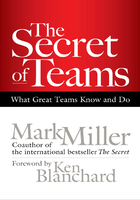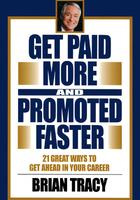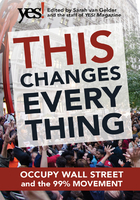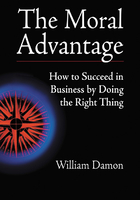Dualities
“Do you walk to school, or do you carry your lunch?” “Is it colder in the winter or in the mountains?” These are dualities, not dichotomies. Not so much “either/or” as “Yes, and …”
A true dichotomy is an either/or thing. Dead or alive. Black or white. But if you take a closer look, a seeming dichotomy often reveals a gray area between the two extremes. There's a difference, for example, between young and old, but there's generally no single birthday when a person goes from being young to being old. The categories of young and old blur into one another, sometimes gracefully, sometimes not.
Would-be dichotomies can also trip people up when they pair two ideas that seem at odds but are actually independent of one another. High quality and low cost, for instance, aren't opposites; something can be one, or the other, or both. Francis Ford Coppola's Godfather trilogy was successful as both film and movie, both art and entertainment, both cinematic triumph and box-office blockbuster.
In most cases, we are better off seeing the duality obscured by the dichotomy. A duality is a pair of ideas that seem mutually exclusive but aren't. Military intelligence. Mass customization. Aesthetic strategy.
“The opposite of a correct statement is a false statement,” said Niels Bohr. “The opposite of a profound truth may well be another profound truth.” In other words, a duality.
Recognizing a duality requires us to identify qualities we generally don't look for—that “other” we pay little attention to and the stuff we dismiss as meaningless, irrelevant, or contradictory. Sherlock Holmes solved one of his most famous mysteries by noticing the dog that didn't bark.
Drawing from two worlds simultaneously, we can deepen our sense of perspective, like the doctor who works for Médecins Sans Frontières (Doctors Without Borders) and the sales manager who coaches Little League. The same thing happens when a market researcher uses mathematically based science to underpin the artistic direction of a successful ad campaign.
At first blush, “aesthetic strategy” seems to comprise two ideas that don't belong together. Aesthetic means artsy, and strategy means business, or so it might seem. But when we look at them separately and more closely, they come into focus as two views of the same reality.
Aesthetic Richness
Everything has an aesthetic. Or, more correctly, everything can have an aesthetic if you choose to give it one. We're accustomed to sensing an aesthetic when painters capture landscapes, musicians play harmonies, and actors create memorable characters. We're less used to sensing an aesthetic when dentists fill cavities, assembly lines run perfectly, and salespeople satisfy customers. It's there to be seen in routine and useful activities, even if you have to stop and look for it.
When we talk about the aesthetic in a piece of art, we are talking about what the creator wants the audience to experience and appreciate. The music in West Side Story has an aesthetic that is jazzy, rhythmic, and operatically lyrical. Leonard Bernstein used a pulsating, angular style to convey the energy and anxiety of teenagers out on tough streets, and long, arching, and lyrical lines to communicate love and grief. The work is more than just its aesthetic, but its aesthetic is what the audience remembers.
We all have aesthetic sensibilities. If you sprinkled parsley on top of a dish, lit a dinner candle, and turned on music to enhance your mood, then you expressed your aesthetic self. Teenagers' bedrooms, with posters taped to the ceiling and dirty laundry on the floor, reveal their aesthetics more than their parents'. One person might look like he slept in a new suit only minutes after first putting it on, while another can sleep on the red-eye and still look stylish.
Our hobbies also reflect our aesthetics. Some people do needlepoint. Some people are gardeners. Some collect guns, or license plates, or almost anything. Whatever our hobbies, the more we learn about them, the more attuned we become to nuances and particulars, to shading and tone. We bring our artistic sensibilities out of the attic. Even if we're not creating high art, to the degree that we're conscious of subtle preferences, we're using our artistic self.
Our cubicles and offices do the same. One of our friends is a psychiatrist. His home office has wine leather chairs, dark wooden bookshelves filled with nonfiction and fiction, readings for work and play, and everywhere are pictures and “tchotchkes,” little items he picked up at moments in his life that he wants to remember. He contrasts his workplace with many of his colleagues' aesthetically sterile offices. Since he spends eight hours a day sitting in his office, he wants to enjoy the space. Moreover, he feels that an office with some aesthetic richness helps his clients feel better, more trusting and relaxed.
Every corporate workspace also makes an aesthetic statement. The statement may be “I don't care” or “I care very much,” “I like modern” or “I'm traditional,” “My office is my space and reflects me” or “Offices reflect the corporate culture.” Some scream, “My real life is in the photos, not in the job,” and some shout, “The Company, the Company, the Company.”
Usually, a common thread runs between different employees at a single office, and you rarely find a random mix of workspace aesthetics. There's engineer gray, there's homey and comfy, there's “We don't fool around” or “We're top of the line (and charge accordingly),” and so on. You can walk into most companies and get an immediate feel for the corporate aesthetic, for the degree to which any one office varies from it, and for what the companies are saying about themselves.
Virtually every aspect of our lives includes an aesthetic component: how we dress, set a table, write a memo, throw a party, decorate a home or office, design or advertise a product. Our ordinary, everyday artistic sensibility says as much about us as do our formal skills, our PowerPoint presentations, and our resumes. When it comes to who we are, the art of the matter gives a richer description than the facts of the matter.
Strategic Perspective
Strategy begins with the very reason your business exists, whether it's to bring beauty into the world, to cure cancer, or to provide healthy food at the lowest cost. Each goal has its own aesthetic.
By contrast, here's something that is not strategy: making a profit. Profit is like health: you can't live without it, but it shouldn't be the reason for your existence. It can tell you how well you're doing, but it can't tell what you ought to do. That's what strategy is for.
Strategy is what the first President Bush called “the vision thing.” Lots of people get “vision” and “mission” mixed up, but it's really quite simple. Christ, for example, had a vision and sent out a bunch of missionaries; he didn't have a mission and send out a bunch of visionaries. Bringing forth a creative vision isn't a democratic process; it's a top-down affair for the leader. Visions and missions have different aesthetics.
A strategy is a plan for the ongoing success of your undertaking. Strategies are for the long run. Tactics, not strategy, change to meet circumstances. Strategy is more about policy than operations. Strategy equals a vision plus a plan for action.
A strategy tells people how to act and how not to act. Every decision made, step taken, and performance given is an enactment of the strategy. Is what you are doing today furthering the strategy? If not, fine-tune your actions until you can answer yes. Otherwise, you're wasting time, energy, creativity, and money.
Strategies have to be clear and memorable. Coca-Cola has been guided for decades by the strategy “within an arm's length of desire.” Soda is an impulse purchase, and you have to satisfy impulses immediately or they dissipate. For Coca-Cola this translated into building a ubiquitous distribution system that made Cokes available everywhere.
If the essence of your strategy has to be written down to be remembered, you're not at its core, its central truth. Life is complex, but the truth is simple. This means a strategy should be stated in a simple and distinctive way, one that is repeatable by different people in their own words yet conveys the same essential message. Aesthetic clarity will go a long way to help everyone in a company implement the strategy.
Some time ago we met with the executive committee of one of the largest banks in the country, one that employed around 80,000 people. We had been shown the corporate strategic plan, which read like pretty standard fare. Who else had seen it? “Only those of us in this room and a few planning staff.” We asked, “Would the counterpart people in your three main competitors know the basic shape of what you say?” “Sure, as we know theirs,” said the chairman. “So,” we asked, “whom are you keeping it a secret from? The other 79,975 employees and all your customers?” Outcome: they went public with a Values and Strategy Campaign.
Contrary to popular opinion, your strategy is worthless unless everybody knows what it is. Leaders often keep their strategies secret out of embarrassment or a failure to even have one. A strategy that you're unwilling to share is probably one that's not so hot to look at.
So what does it take to combine aesthetic sensibility and business?
Aesthetic Strategy
An aesthetic is the style, structure, and flavor of a work as experienced by the consumer. Retailers like Ralph Lauren and the Gap have carefully constructed aesthetics—the tastes of the secure rich and of universal youth, respectively, purveyed to the middle class. Southwest Airlines, Ryanair, and JetBlue share an aesthetic that is both economic and artistic: flying can be cheap and fun. The New York City Ballet's aesthetic is to preserve the Balanchine look and feel. IBM's aesthetic is the customer's experience of working with a first-rate vendor who has an unimpeachable reputation and is more than occasionally cutting-edge.
Dunkin' Donuts and Krispy Kreme both have the aesthetic of freshness (not to mention alliterative names). Dunkin' Donuts throws out every pot of coffee after thirty minutes if it's not sold. Krispy Kreme sells the experience of buying donuts right out of the glazing machine while the neon sign in the window flashes “Hot Doughnuts Now.”
Not only can a business have an aesthetic, its strategy can have an aesthetic. An artful strategy connects a firm's vision to its capabilities. Even if everyone outside the firm knows the strategy, they probably can't duplicate the web of capabilities that the firm, its suppliers, and its distributors have built up. Everybody knows that Wal-Mart's strategy is “everyday low prices,” but that doesn't mean everybody knows the secret to matching their cost structure. Although you may not think Wal-Mart is aesthetic, there's art in a strategy everybody knows but nobody can imitate.
Apple's moves in the recorded music industry are another example of a beautiful strategy. Here's the story. Simple online file-sharing programs sent tens of millions of listeners to other fans, instead of to music stores, to get the tunes they want for free. The music industry—oligopoly might be the better word—responded with legal actions against twelve-year-olds and their families in the vain hope that would stop the practice. But you can't alienate sixty million customers; it's simply not a beautiful strategy. CD sales dropped by 30 percent, and the industry still hasn't turned a strategic corner. It still hasn't figured out a viable new business model.
Enter Steve Jobs and Apple. They leveraged their well-known capabilities in user-focused design, and Jobs's clout as CEO of Pixar Studios, to breathe new life into Apple's twenty-year-old strategy of selling integrated hardware and software, instead of one or the other.
Apple's strategy offered music lovers what they want—a legal and easy-to-use interface. Customers could buy songs one at a time for ninety-nine cents each instead of buying them bundled up in albums of uneven quality. First, Apple proved the model worked on their own proprietary hardware, and then they rolled it out on PCs.
Critics said you couldn't take on Microsoft and its Windows Media Player platform; the customers said otherwise. Apple knew that their customers' needs, their competitors' failure to act, and their own capabilities all pointed to the opportunity to do something both “insanely great” and beautiful. Apple is justly famous for its stylish products and its spare, compelling advertising, but its business model for iTunes was one of its most beautiful creations.
Physicists have an expression for this kind of solution. They say that when such elegance and simplicity are in the formulation, you're more likely to be right. Similarly, in detective fiction, an elegant solution is both simple and inevitable. “Elementary, my dear Watson.” Aesthetic strategies are elegant—simultaneously simple, stylish, classic, and apt.
Getting to Yes … And
As in the case of “aesthetic strategy,” getting past the either/or of a false dichotomy is liberating and energizing. We can draw from two pools of resources instead of one, and we can benefit from the experience of successful companies' approaches. At the same time, we can draw on an artistic sensibility that puts us in better touch with our customers' needs and our own capabilities. No either/or choice required. “Do I contradict myself?” asked Walt Whitman. “Very well then I contradict myself (I am large, I contain multitudes.)”
In their classic book Getting to Yes, Roger Fisher and William Ury wrote that negotiations don't have to be a game of “I win/you lose.”[1] Even though “my interests” and “your interests” might seem like a dichotomy, they're not. When the two sides in a negotiation focus on their interests instead of their bargaining positions, they are much more likely to get to a win-win solution. The greater the differences in what each party is looking for, the greater the opportunity for beneficial outcomes. Or, to put it as a mathematician would, bad negotiations are zero-sum games, and good negotiations are positive-sum. In bad negotiations, one side's demands are met with either a flat-out “no” or, more encouragingly, with a “No, but …” In good negotiations, one side's proposal is met by the more promising response “Yes, but …”
Actors and improvisational comics take “getting to yes” a step further. Sketch comedy like Saturday Night Live and improv like Whose Line Is It Anyway? operate with one cardinal rule: don't stop the momentum. Wherever the scene finds itself heading, that's where you have to go. You can add to what's going on, but you can't pretend that what has been said and done didn't happen. Actors prepare for group improvisation by doing an exercise called “Yes, and …” They tell a story, adding a line at a time to what the person before them said. No matter what convoluted concoction they get handed (“There's this deli and the guy behind the counter is a samurai …”), the only response is “Yes, and …”
Getting to “Yes, and …” is finding the duality in a situation. In this chapter we used the oxymoron of aesthetic strategy as an example of a duality. The strategy side of the duality draws on the economic flow of business: how to commit your resources to satisfy your customers and out-maneuver your competitors. The aesthetic side draws on the artistic flow of business: finding creative ways to meet your audience's subjective needs and to learn from your competitors. The two flows are complementary sides of one duality.
In the next chapter, we'll talk about the two flows in more detail. We'll talk about the resources that each draws on, the processes they exploit, and the desires they satisfy. Since most people have a greater familiarity with the economic flow of business, we'll spend more time on the artistic flow. But our objective will be to show how the two flows make up a duality. When you start seeing them that way, you'll end up with more resources to work with and better ways of approaching your work. If you can draw on both sides of the duality, you've got a distinct competitive advantage.
注释:
[1]Roger Fisher and William Ury, Getting to Yes: Negotiating Agreement Without Giving In (Boston: Houghton Mifflin, 1992).















